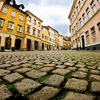Europe's Top Fire Festivals
Andy Hayes
Perhaps it’s the cold weather in many parts of the continent, or maybe it is just related to Europe’s ancestry of Viking and Celtic blood, but the largest and most popular fire festivals can be found in this part of the world. Read on to discover three of the best and find out the story behind their unusual rituals.
Up Helly Aa, Shetland Islands, Scotland
On the last Tuesday of January, one of the most remote and sleepy parts of Europe becomes alive and on fire. In the town of Lerwick, in the Shetland Islands off the coast of Scotland, residents pay homage to their Viking roots by following tradition and practically setting fire to their city. The festival is the largest fire festival in Europe and attracts visitors world-wide to see this spectacle in such a rural setting. The evening begins with a speech from the Guizer Jarl, the figurehead of the event and a man dressed in Viking garb. He is surrounded by hundreds of men also dressed in costume and carrying burning torches. Next to them is a huge replica of a Viking warship, well-built as if it just was pulled out of the sea that day. After making his speech, the Guizer Jarl and his fellow Vikings, named the guizers, begin to sing the traditional Up Helly Aa song. Spectators listen with anticipation as the song concludes, because when it does, the guizers all once throw their torches into the warship, and within a matter of seconds the ship roars into flames. After setting the ship alight, the guziers sing another traditional song and then depart for the various “halls”. The halls are simply locations that have been set up for food and drink as well as dancing. Locals stay in a hall for the evening, but the guziers are required to visit each and every single hall and dance with the guests. This goes on throughout the night and into the early hours of the morning of the next day.
Beltane Fire Festival, Edinburgh, Scotland
On the 30th of April one of the most picturesque spots on Scotland’s capital city becomes the site for an unusual pagan festival. Underneath the iconic National Monument (a partial replica of the Acropolis in Athens) spectators witness the arrival of the May Queen, who symbolizes Mother Earth, with her four warriors. Their arrival represents the arrival of spring, and indeed the Beltane festival is an event dedicated to fertility, both of the farmland as well as of the participants. The queen’s procession visits various groups of performers scattered about the top of the hill around the monument, each representing the primary elements: air, earth, fire, and water. Each performance concludes with the lighting of massive images reflecting the respective primary element. While the queen is touring the performances, she is attacked by men painted in red, said to represent the devil. The queens’ warriors defeat the attackers, and the queen continues her circuit back to the monument. The event culminates in a death at the hand of the queen’s protectors. Her courtier, a man in green, who has been carefully watching her the whole time, is struck down by the queen’s warriors. However, not all is lost, as the queen revives the green man, who represents a spring seedling. To celebrate his revival and their impending marriage, the queen and the green man light two large bonfires. All of the participants and spectators of the festival pass between these fires to purify themselves and give them fertility for the upcoming season.
Las Fallas, Valencia, Spain
Every year on the 19th of March, Valencia erupts into a blaze of glory as over 700 paper-mache statues, called fallas, are burnt to the ground. The city is filled not only with residents but also firefighters, who stand by to control the flames that erupt in nearly every city square, large or small. The origin of this unusual ritual is unknown. Some point to early pagan rituals, others say it is a Christian ritual as some of the first statues were actually Catholic religious figures. This is led credence by the fact that the 19th of March is the Saint Day of San Jose, the official patron saint of Valencia. A huge amount of work goes into the creation of the fallas. The larger statues are commissioned by committee, as much preparation and planning is required. They typically include human features with exaggerated features, especially topless women in provocative poses. Some of the statues are humorous; others are just ugly or obscene. Surrounding the larger statues are a number of smaller statues, often made by the children in the neighboring area. Another key feature of the event are the virgins. A more recent feature of the festival, girls in bright dresses carry flowers parade through the streets, making their way to a central figure of the Virgin de Los Desamparados (Virgin of the Defenceless), where the girls leave their flowers. The evening culminates in a spectacular fireworks display to accompany the burning of the largest fallas in the main square. The spectators take part, cheering on the statue as it the flames lick the sky and the square is filled in an array of color.
Featured Articles
No-one likes to be cliché but when you're faced with planning a trip to Europe it can be tempting to follow the crowd.
The UK is known for many things: rain, a scandalous royal family, old buildings and bad food all spring to mind.
People often think that travel in Europe is easy; that cultural gaffes aren’t an issue and that the challenges of Africa or Latin America don’t apply.
Every year in August people get together to throw tomatoes at each other. I hate tomatoes, I think they are disgusting, so...
Free Backpacking Europe Planning & Essentials Guide
Download/More info on the Backpacking Planning and Essentials Guide
Featured Articles
No-one likes to be cliché but when you're faced with planning a trip to Europe it can be tempting to follow the crowd.
The UK is known for many things: rain, a scandalous royal family, old buildings and bad food all spring to mind.
People often think that travel in Europe is easy; that cultural gaffes aren’t an issue and that the challenges of Africa or Latin America don’t apply.
Every year in August people get together to throw tomatoes at each other. I hate tomatoes, I think they are disgusting, so...
Free Backpacking Europe Planning & Essentials Guide
Download/More info on the Backpacking Planning and Essentials Guide





